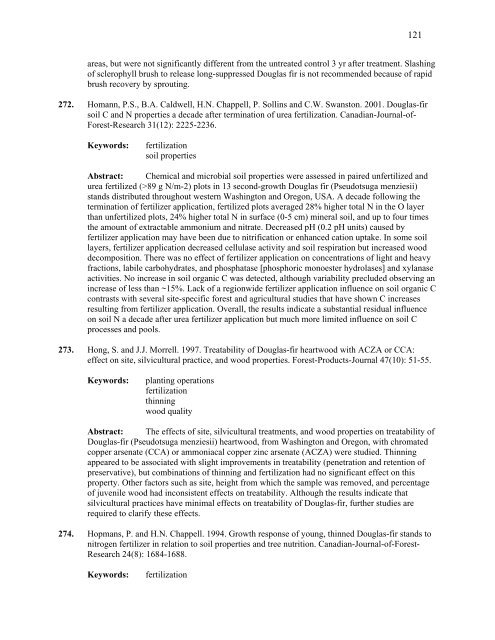IntensIve sIlvIculture - Forest Science Labs - Research Network ...
IntensIve sIlvIculture - Forest Science Labs - Research Network ...
IntensIve sIlvIculture - Forest Science Labs - Research Network ...
You also want an ePaper? Increase the reach of your titles
YUMPU automatically turns print PDFs into web optimized ePapers that Google loves.
121<br />
areas, but were not significantly different from the untreated control 3 yr after treatment. Slashing<br />
of sclerophyll brush to release long-suppressed Douglas fir is not recommended because of rapid<br />
brush recovery by sprouting.<br />
272. Homann, P.S., B.A. Caldwell, H.N. Chappell, P. Sollins and C.W. Swanston. 2001. Douglas-fir<br />
soil C and N properties a decade after termination of urea fertilization. Canadian-Journal-of-<br />
<strong>Forest</strong>-<strong>Research</strong> 31(12): 2225-2236.<br />
Keywords: fertilization<br />
soil properties<br />
Abstract: Chemical and microbial soil properties were assessed in paired unfertilized and<br />
urea fertilized (>89 g N/m-2) plots in 13 second-growth Douglas fir (Pseudotsuga menziesii)<br />
stands distributed throughout western Washington and Oregon, USA. A decade following the<br />
termination of fertilizer application, fertilized plots averaged 28% higher total N in the O layer<br />
than unfertilized plots, 24% higher total N in surface (0-5 cm) mineral soil, and up to four times<br />
the amount of extractable ammonium and nitrate. Decreased pH (0.2 pH units) caused by<br />
fertilizer application may have been due to nitrification or enhanced cation uptake. In some soil<br />
layers, fertilizer application decreased cellulase activity and soil respiration but increased wood<br />
decomposition. There was no effect of fertilizer application on concentrations of light and heavy<br />
fractions, labile carbohydrates, and phosphatase [phosphoric monoester hydrolases] and xylanase<br />
activities. No increase in soil organic C was detected, although variability precluded observing an<br />
increase of less than ~15%. Lack of a regionwide fertilizer application influence on soil organic C<br />
contrasts with several site-specific forest and agricultural studies that have shown C increases<br />
resulting from fertilizer application. Overall, the results indicate a substantial residual influence<br />
on soil N a decade after urea fertilizer application but much more limited influence on soil C<br />
processes and pools.<br />
273. Hong, S. and J.J. Morrell. 1997. Treatability of Douglas-fir heartwood with ACZA or CCA:<br />
effect on site, silvicultural practice, and wood properties. <strong>Forest</strong>-Products-Journal 47(10): 51-55.<br />
Keywords: planting operations<br />
fertilization<br />
thinning<br />
wood quality<br />
Abstract: The effects of site, silvicultural treatments, and wood properties on treatability of<br />
Douglas-fir (Pseudotsuga menziesii) heartwood, from Washington and Oregon, with chromated<br />
copper arsenate (CCA) or ammoniacal copper zinc arsenate (ACZA) were studied. Thinning<br />
appeared to be associated with slight improvements in treatability (penetration and retention of<br />
preservative), but combinations of thinning and fertilization had no significant effect on this<br />
property. Other factors such as site, height from which the sample was removed, and percentage<br />
of juvenile wood had inconsistent effects on treatability. Although the results indicate that<br />
silvicultural practices have minimal effects on treatability of Douglas-fir, further studies are<br />
required to clarify these effects.<br />
274. Hopmans, P. and H.N. Chappell. 1994. Growth response of young, thinned Douglas-fir stands to<br />
nitrogen fertilizer in relation to soil properties and tree nutrition. Canadian-Journal-of-<strong>Forest</strong>-<br />
<strong>Research</strong> 24(8): 1684-1688.<br />
Keywords: fertilization
















